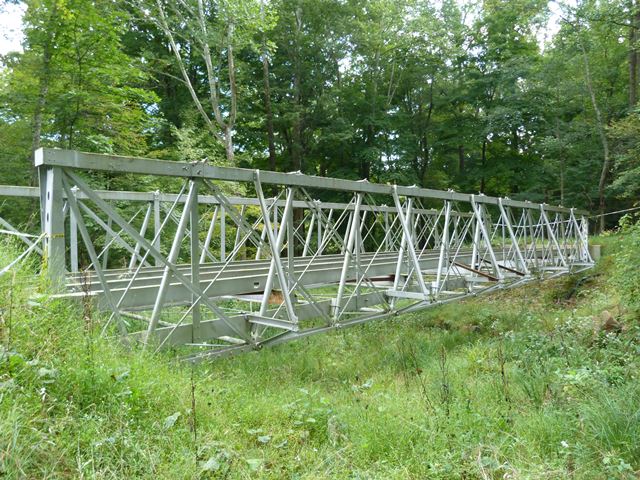We Recommend:
Bach Steel - Experts at historic truss bridge restoration.
BridgeHunter.com Phase 1 is released to the public! - Visit Now
Falling Rock Camp Iron Bridge
Doc Brown Bridge

Primary Photographer(s): Nathan Holth
Bridge Documented: September 11, 2015
Rural: Licking County, Ohio: United States
Not Available or Not Applicable
64.5 Feet (19.7 Meters)
71.5 Feet (21.8 Meters)
14.3 Feet (4.36 Meters)
1 Main Span(s)
45XXX15

View Information About HSR Ratings
Bridge Documentation
View Historic American Engineering Record (HAER) Documentation For This Bridge
HAER Drawings, PDF - HAER Data Pages, PDF

This is the only surviving Post type truss bridge in Ohio and one of only three known bridges of this type in Ohio. This is immediate national significance as an example of a rare experimental type of truss configuration characteristic of the earliest metal truss bridges. Additional national significance is derived from the fact that all compression members of this bridge are made of cast iron. It is one of the finest and most significant historic bridges in Ohio and the United States.
The bridge was built ca. 1872 and was relocated in 1927 and sometime at or after 1931. The 1931 move brought it to the Boy Scout Camp. More recently in 2012 the bridge has again moved. As of 2015, the bridge had been repainted in its new location, but no deck was present.
Information and Findings From Ohio's Historic Bridge InventorySetting/Context The bridge, which is closed with the deck removed, formerly provided an entrance to the Boy Scout's Camp Falling Rock. The setting is rural. There is a T-intersection with Rocky Fork Road at the bridge's east end. Beyond the west end of the bridge is the scout camp. The bridge is owned by the Boy Scouts. Physical Description The 1-span, 66'-long, Post truss bridge has had its deck removed and is slightly leaning toward its southwest corner due to the failure of the abutment. The truss lines are a rare Post-truss configuration with cast-iron compression members and wrought-iron tension members. The castings are a marvelous testament to the foundrymen's skill with special considerations made for how the members would be joined together using a combination of bolts, pins, and compression fittings. For a full description, see HAER OH-89. Integrity The bridge was relocated here in 1931, but has had little modification since that time. The truss lines appear to be complete and unaltered. The Boy Scout's removed the bridge deck as a safety measure due to its deteriorated condition and the failure of the abutment. The abutment failure is jeopardizing the bridge's survival. Summary of Significance The bridge is a very rare example of a metal Post truss. The Post truss design, named after engineer Simeon Post, was popular during the 1860s and 1870s, and best known for its use with long-span railroad bridges. The design is distinguished by the slightly inclined verticals, which, according to Post, resulted in savings in material. Most Post trusses were combination timber and iron bridges, but they were also all-metal trusses representing the technologically significant transition from the era of wood trusses to that of cast and wrought-iron trusses. The only two other known metal Post trusses are in Lancaster, Massachusetts. The bridge is of exceptional technological and historical significance. Justification The truss design is very rare. It has exceptional significance. Bridge Considered Historic By Survey: Yes |
![]()
Photo Galleries and Videos: Falling Rock Camp Iron Bridge
Bridge Photo-Documentation
Original / Full Size PhotosA collection of overview and detail photos. This gallery offers photos in the highest available resolution and file size in a touch-friendly popup viewer.
Alternatively, Browse Without Using Viewer
![]()
Bridge Photo-Documentation
Mobile Optimized PhotosA collection of overview and detail photos. This gallery features data-friendly, fast-loading photos in a touch-friendly popup viewer.
Alternatively, Browse Without Using Viewer
![]()
Maps and Links: Falling Rock Camp Iron Bridge
This bridge is located in the Falling Rock Boy Scout Camp.
Coordinates (Latitude, Longitude):
Search For Additional Bridge Listings:
Bridgehunter.com: View listed bridges within 0.5 miles (0.8 kilometers) of this bridge.
Bridgehunter.com: View listed bridges within 10 miles (16 kilometers) of this bridge.
Additional Maps:
Google Streetview (If Available)
GeoHack (Additional Links and Coordinates)
Apple Maps (Via DuckDuckGo Search)
Apple Maps (Apple devices only)
Android: Open Location In Your Map or GPS App
Flickr Gallery (Find Nearby Photos)
Wikimedia Commons (Find Nearby Photos)
Directions Via Sygic For Android
Directions Via Sygic For iOS and Android Dolphin Browser
USGS National Map (United States Only)
Historical USGS Topo Maps (United States Only)
Historic Aerials (United States Only)
CalTopo Maps (United States Only)

